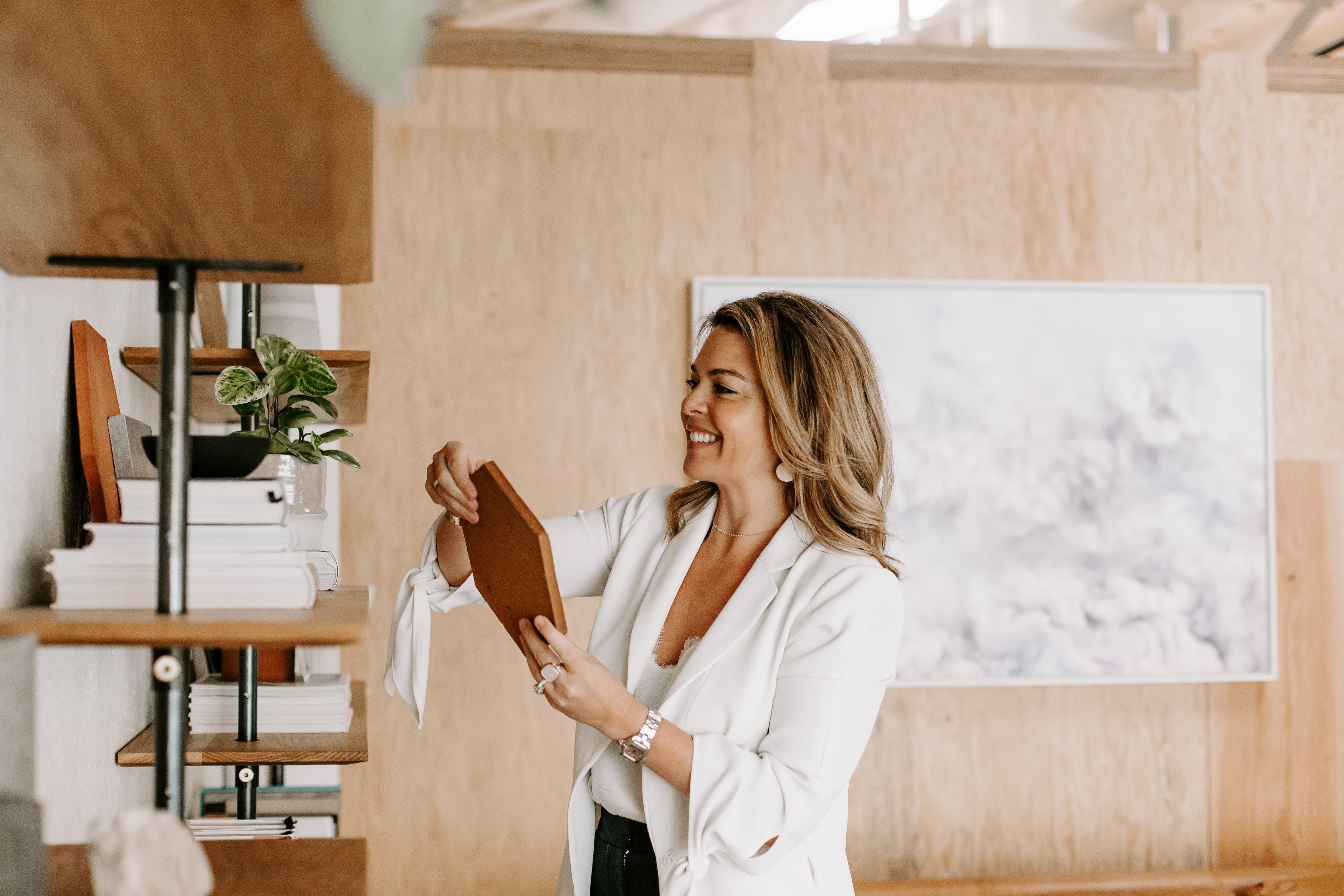The 50 States Project is a series of candid conversations with interior designers across the country about how they’ve built their businesses. This week, Portland-based designer Holly Freres of JHL Design tells us how creating a board of directors enhanced her business, how she’s finding success in a slowdown, and why she likes it when her staff pushes her out of her comfort zone.
What was your path into the design world?
It’s definitely an unconventional one. I have always had an entrepreneurial spirit, and I did a lot of different things in my 20s trying to find the right career path. I dabbled in photography and writing; worked for a worldwide PR firm, which gave me great corporate experience; and did graphic design and marketing on the side. I always found myself telling people’s stories—about their office, their makeup line, or whatever I was writing about—and then having a really strong visual tie to that. Sometimes that meant I was weighing in on things that I wasn’t necessarily hired to do, but I always [saw the connection] between business and aesthetics.
After traveling, living abroad in New Zealand, and having all these different jobs, I came back to Oregon, where I was raised, for some family time. I thought I’d just get a job. I had a strong resume, but it was 2002 and people weren’t hiring. My mom had a design business doing commercial interiors, which she started while I was in high school, and she said, “Do you want to work for me?”
Was it immediately a good fit?
We were pitching big concepts to a development company. So what is a new 40,000-square-foot building going to look like? What is it going to feel like? Who are the anchor tenants, and what’s their design approach going to be? I thought that was exciting, because it was a way to tell a corporate story through design. And then there was the business side—we had to make the budget work. It was a nice balance for both sides of my brain.
A couple years later, my mom retired, and I decided to keep going. From there, it evolved into a different design firm pretty quickly. Within two years, we were doing residential work and refining our look.
What was driving that shift?
We started picking off, “No, that’s not what we want to do,” or “No, that’s not what we’re good at.” For a lot of years now, the business was 50 percent commercial and 50 percent residential. I liked the combination—the very emotional side of the residential work and the pragmatic style of commercial work, with quick decisions and solid parameters. I liked having that mix. And a lot of our clients were both. They were commercial clients and we worked on their personal homes.
Is that still true today?
We have almost all residential work right now. It’s always been a mix, but it is very much [tied to] what’s happening in the economy. Right now, people are spending money in their homes, but they aren’t investing in their business [spaces] nearly as much because they are working from home more. We’re doing restaurant work—Portland’s having a big resurgence of restaurants coming back into the city, which is exciting—and we’re doing winery projects, which is also growing in our area right now, as the climate [changes] in Oregon and lots of people from California move up here. We’ve dabbled a little bit in hospitality the last couple years, doing bed-and-breakfasts and high-end hotels, which feels really fun. It’s also closer to residential, versus doing a corporate office.
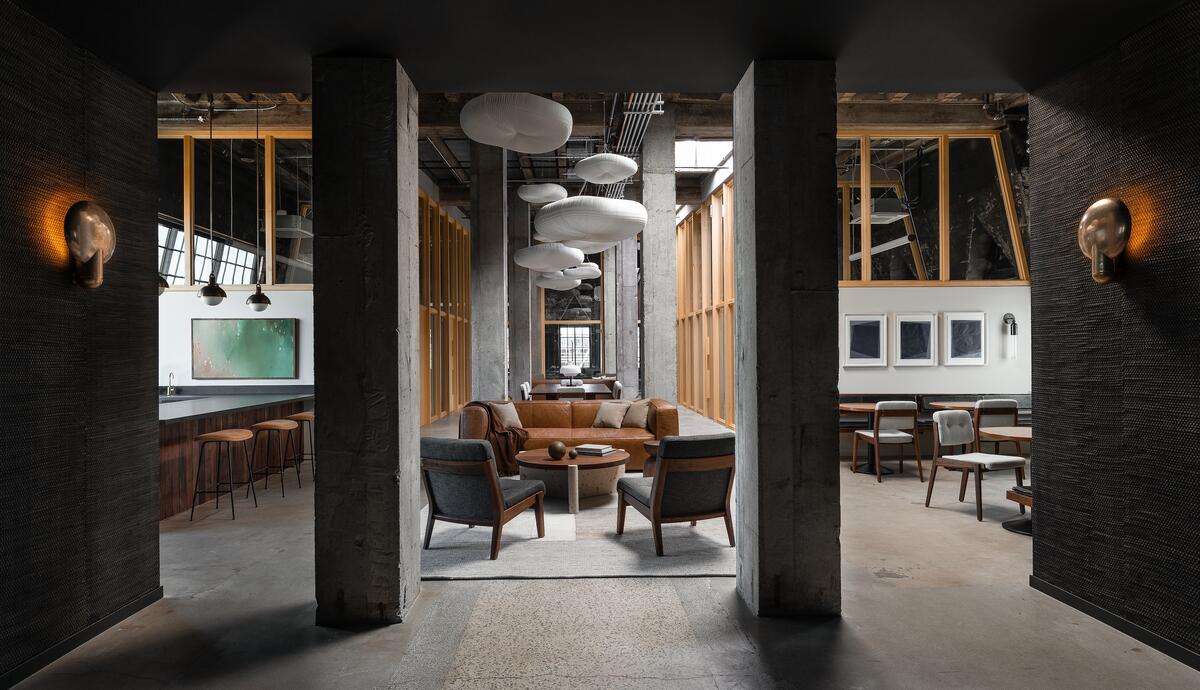
How do you decide what you say yes to these days?
When an inquiry comes in, we look at the client, the budget and the timeline. We want to feel like they’re good people who understand and appreciate what we provide, and that they are willing to go into the process with us. Does their budget fit with what we can work within? If a project is under $500,000, it’s really not a good fit for JHL. And how can we fit their budget into all the things that they want from a design perspective? Those are things that people are paying more attention to with interest rates right now, and especially in an election year. The timeline part is a pretty significant one too. We have 10 people on staff right now, and I’m really cognizant of not overextending our team. I try to mitigate burnout, so we usually have a pipeline—there’s a [forecasted] date that we could start a project, and some people aren’t willing to wait.
Have you always been protective of your team in that way, limiting the number of jobs you’re running at one time?
I haven’t. You know, I was just reading an article about a colleague of mine who has a Portland design firm with a staff about the same size as mine, and the number of projects that she was working on at the time was exceptionally greater than what we’re working on. I had a little FOMO moment where I was like, “Oh, what’s she doing that I’m not?” But I think the difference is not just the number of projects, it’s the complexity and size of them.
With the team you have now, what is a normal workload? What feels right?
My ideal is to have two to three ground-up custom homes and then about 12 to 15 interior renovation projects a year, depending on the size of those. The renovations can be [anything from] $500,000 to $15 million.
We have a lot of different design staff—we have licensed architects all the way down to people who do just FF&E, and each of those business arms needs a different type of project to stay profitable. Our procurement team needs designers to be specifying furniture so they can put the sales orders together and track all of that. The interiors people need significant renovation projects because they want to be touching all the interiors. And then the architecture team wants to design homes and do ground-up construction—they want to be doing significant work, not just a kitchen renovation or an addition. We try to feed all of those people creatively and balance the flow for our top-line revenue.
Did you always have architects in-house?
We introduced architecture as an in-house service in 2019. My husband [David Horning] and I actually combined our companies, and he oversees that side of the business. Before, we used to subcontract that part out. If people came to us and said, “Hey, we want you to design a home,” we would say, “Great, let’s partner with this architect. We’ll do the interiors with all the interior architecture, and they’ll do the core and shell.” Now we can offer [those services], which is really exciting and still so cohesive and rewarding.
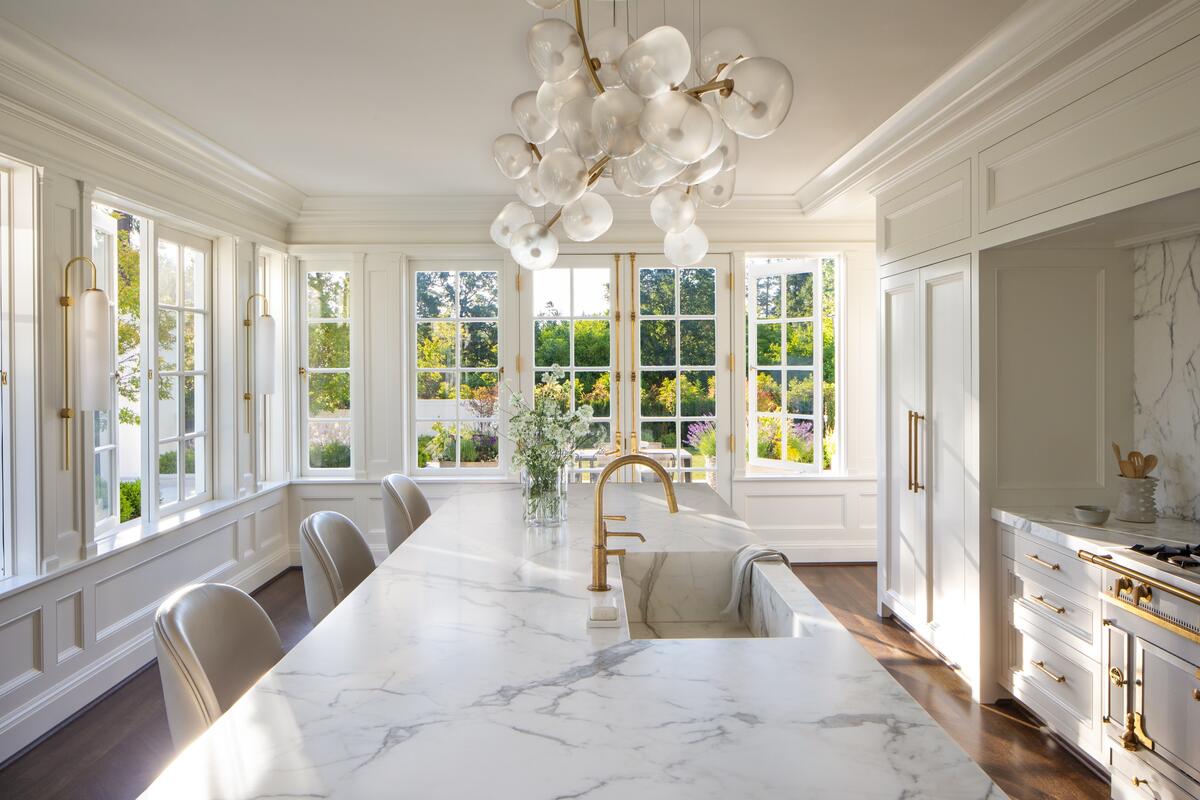
How did that change the way you worked, or what you were looking for?
It didn’t really change our approach or our process, but it changed who we were looking to hire us. We did a deep dive last year into who our ideal client is: what they do, what they drive, what they wear, where they shop. When we fine-tuned this ideal client, it’s really describing someone who is doing ground-up construction, so our marketing efforts since then have been pretty direct in reaching those specific people.
What was driving those conversations? Were you looking at your most successful projects in the past, or was it from more of an aspirational perspective?
It was both. We thought about what projects really felt successful for our team from an aesthetic approach, but also a client service approach: Did they trust the process? Did they look to us to provide that expert advice, or were they just wanting a draftsperson to execute their vision? That’s definitely happened, and there’s nothing wrong with it, but it’s a bit limiting when clients get into the weeds like that, and it cuts us out of the opportunity to show them something that they might not have thought of, which is a really important part of our design process.
So what has worked or not in the past definitely influenced how we described our ideal client. But I also think we’re still looking for that ideal client. When someone walks in the door, we’re like, “OK, they’re close. They’ve got four out of five traits. Let’s go for it, right?” But I haven’t had a five out of five yet.
Does that person exist?
You know, I’m not sure.
You said your marketing is very targeted. What does that look like?
We’re asking specific questions with our marketing plan: Where are those people getting their information? That’s going to shape what publications we look at getting published in and where we want to sit on Instagram. We’re trying to be very specific about geographic markets—for example, we’re totally open to being in an international publication or winning an international award. We’re not necessarily looking for work there, but we realize that our ideal client is probably flying to London or Paris. They’re in those markets and they’re going to be picking up those publications, and that’s where they’re going to read about us. That’s the strategic part of [defining] who our ideal client is: [understanding] what they are reading and how we can meet them in a setting where they’ll be inspired by what we’re doing.
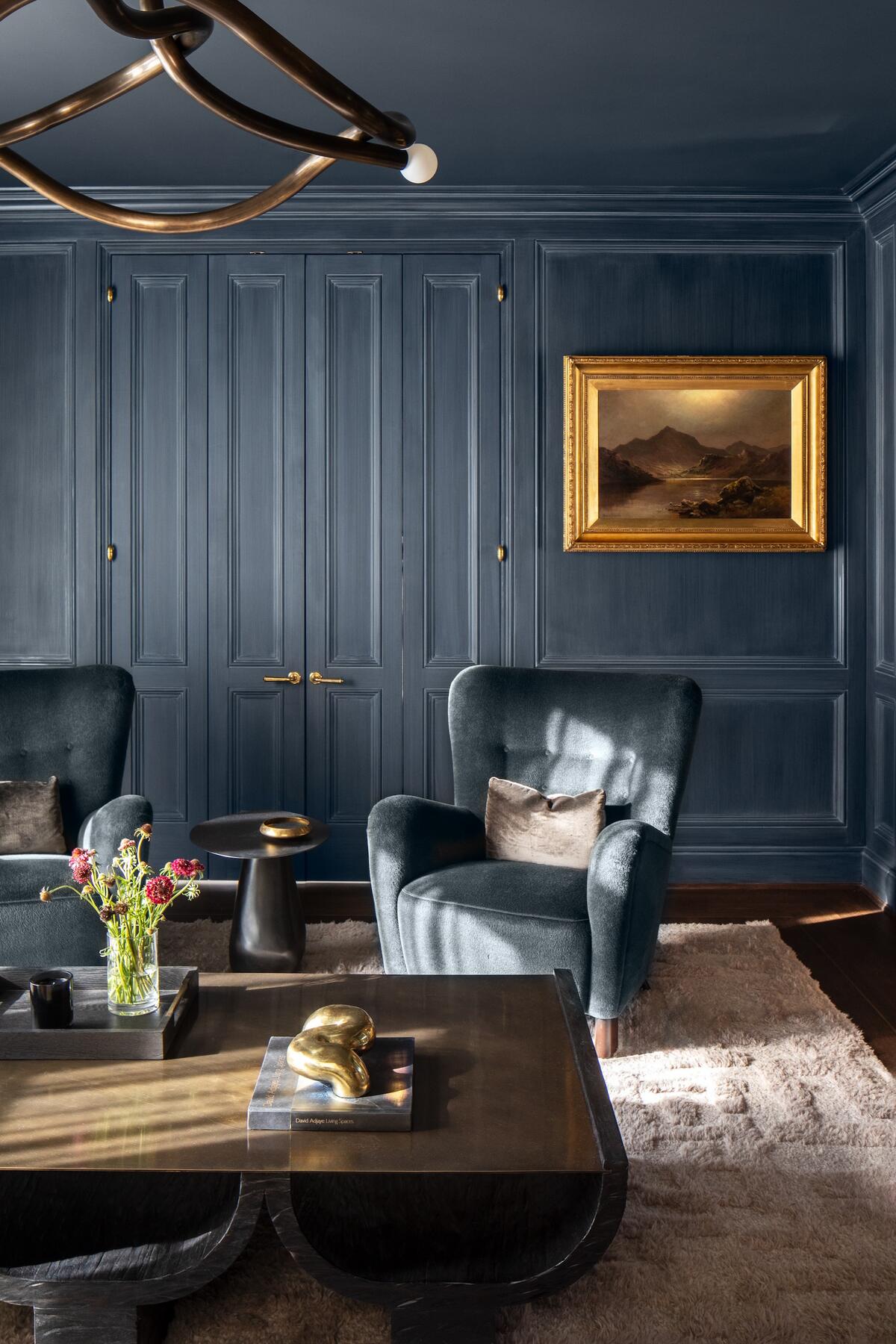
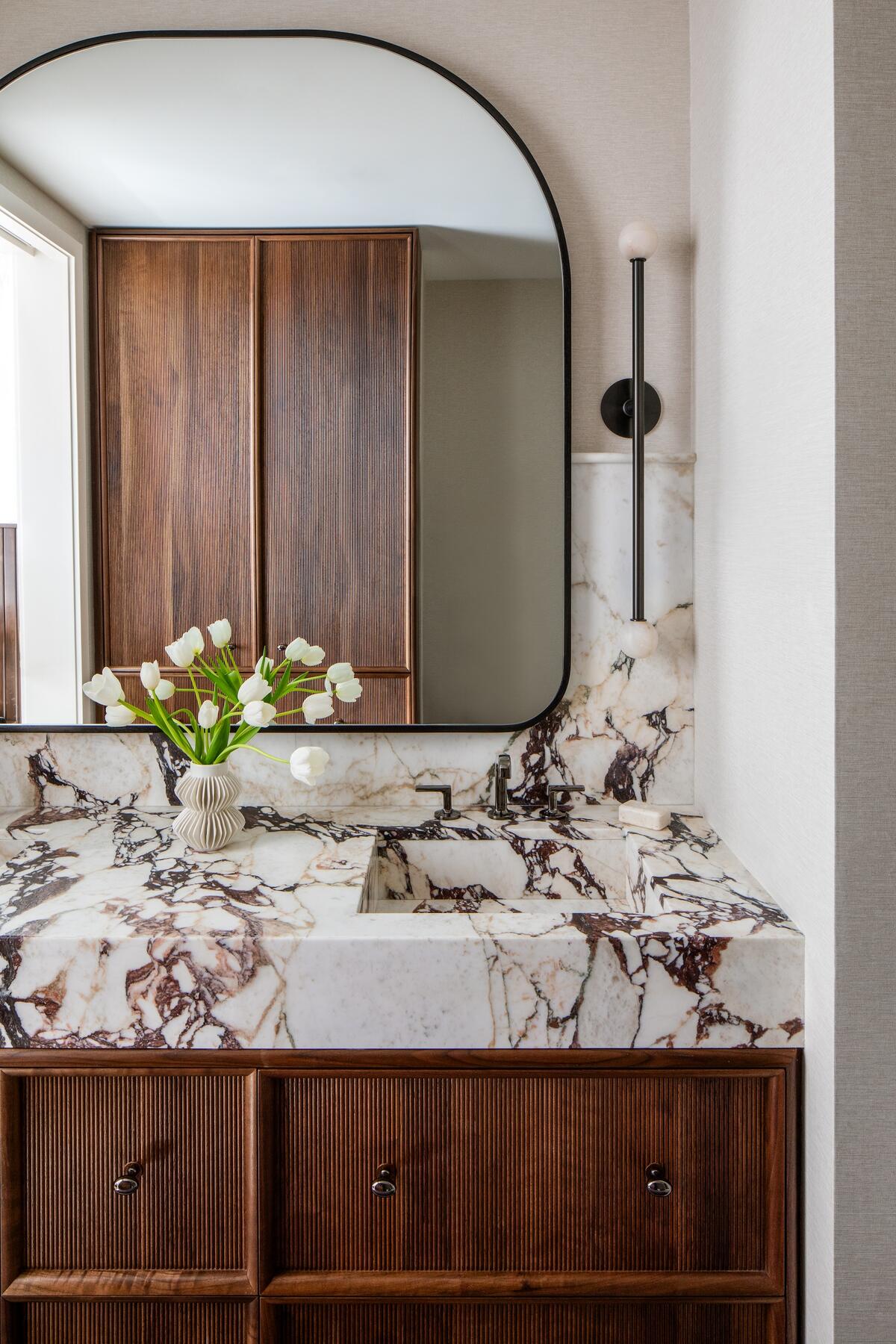
It’s been more than two decades since you took over the firm. Beyond the type of work, how has the business evolved?
Well, at the time, it was a team of two people: me and my mom. My sister worked with us for a little while, too, so it was the three of us. She did the books and a lot of the operations; my mom did new business; and once we settled into our respective roles, I was leading design. After my sister [left to be a mom] and my mom retired, I was doing all the jobs. They were both very good about guiding me in how to set things up, but I was running six projects at a time and it was a lot. I hired my first employee in 2005.
What were you hiring for back then?
Somebody who could sit and design. I needed somebody with good style and taste, who could manage the drafting production portion of the project. I was out meeting with contractors and clients.
My first hire is still a good friend of mine. I had so much fun working with her, and it helped me realize that I need somebody to collaborate with. It expanded my creativity, and also I could do almost twice as much work. She eventually started her own business. But working with her really set the tone for me [when I made future hires]: What did I enjoy about that relationship, and how can I grow my team in a way that feels just as fulfilling?
How has your role evolved as the team grows?
I spend a lot of time nurturing my clients and my staff. I’m also the one doing the strategic planning for the business: What are we going to be in three years? Where do I see a potential roadblock coming up with what’s happening in our community, in our economy? And how do we want to grow as a team?
I have come to a place in my career where I can recognize that there are people on my team who are better designers than me. I think my ego struggled for a little while because I wanted to hire the best, but I had a little bit of imposter syndrome—like, if I put all these great designers on my team, are the people who hire us going to feel like they’re getting [shorted] because I’m not in the forefront of this project, or are they going to be blown away by what we can produce for them? For me, it was a slow letting go of being in the senior seat on every project. But I have found so much joy and pride in the fact that my team can present where they are in the process to me, or we’ll do a dry run for presentation, and I’m like, “I wouldn’t change a damn thing. This looks fantastic.”
I feel like I’m now training people about the JHL way—our overall aesthetic, but also how we provide client service—and then letting them come into their own creative space. They have the opportunity to make something way more funky than I would, which has sort of pushed me out of my comfort zone, and I’m totally OK with it.
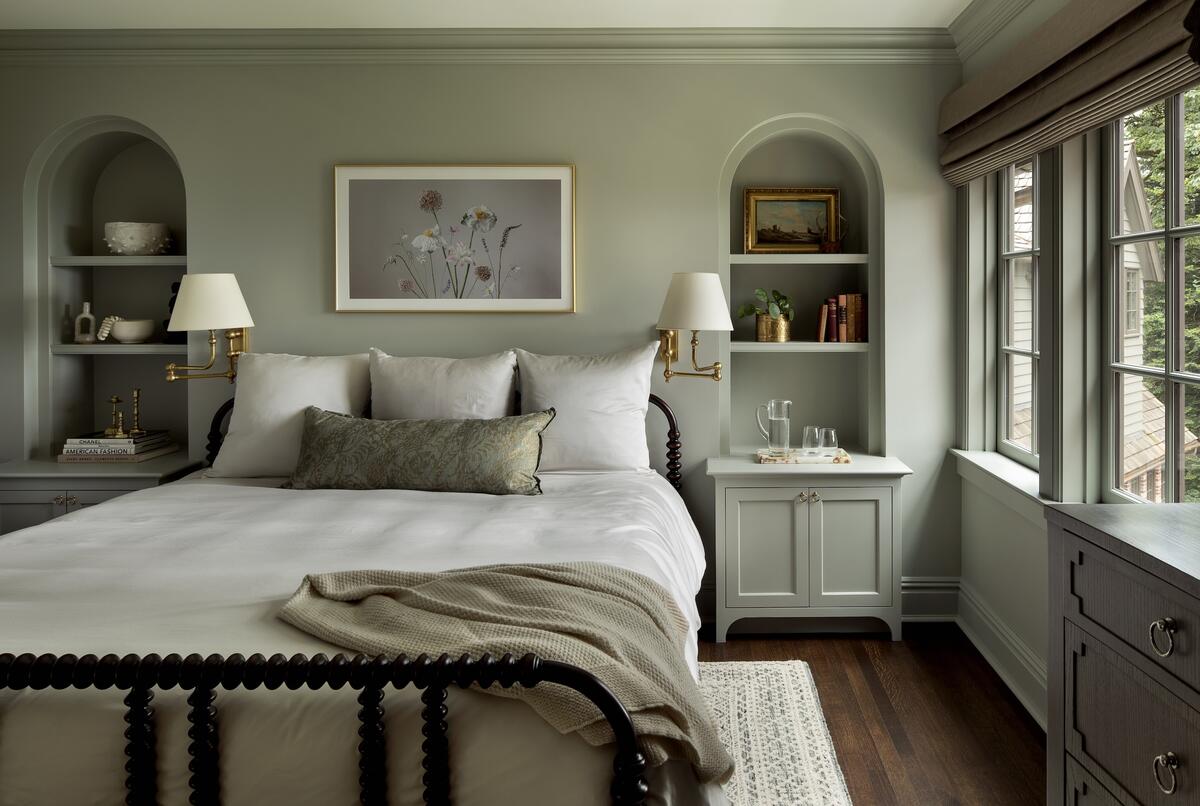
How have you organized your team, especially now that you’ve folded in your husband’s firm?
I am the principal, and I’m still very heavily involved in the design projects, especially on the interiors side, but I have several layers in between me and the staff—meaning that there are senior team members who review stuff before I see it now. We have a marketing director; a director of operations who oversees operations and procurement; and then my husband, David, is our design director. He sits at the top of all the designers and interacts very vertically with junior, mid-level and senior designers on the architecture and interior side. I’m also on the business side—contract writing, budgets, forecasting design time and checking in with employees—while he’s really in the weeds on the design aesthetic. We actually met working together in 2006 and have such a synergistic design approach, so it’s been great to release that side to him in some ways.
So many people I talk to hate the things that you just mentioned—the contract writing, managing billable hours. Is work still a creative outlet for you?
There is a lot of joy, and I’m so grateful for where I am in my career. I think a lot of people burn out at about this stage, but I love it. I love bringing a client in and introducing them [to our team]. I get excited about looking at all the pretty things, especially when we’re doing layouts of all the different finishes and we have the whole house set out and you can see how good it feels. And I love the end, doing the photo shoot. I get to do a pretty heavy concentration of those components. And even though I do the contract writing and the forecasts, I have people on my team who prep a lot of that stuff, so I’m not in spreadsheets or going through hours in Harvest all the time. The mentorship and bringing people up to where they want to be in their career is a very big passion of mine, and I get to do a lot of that at work.
How do you create space for growth for your team members?
I think understanding how they want to grow is the first step. We get together as a team every quarter, but it’s an all-day event twice a year. We call it Summit Day, kind of like you’re on the top of the mountain and you’re looking around. We just had our summer event, and we did an exercise called “100 Things.” It was actually a three-month exercise where we asked everyone on the staff, including myself, to write 100 things they want to do before they die. At the summit, we each shared three things [from that list] that we thought we could and would accomplish in the next 12 months, three things that we were afraid might never happen, and three things that would surprise the team. I really wanted to understand what people’s deep desires were—not just, “I want to be a design director someday.” Do you want to own a shop? Do you want to adopt a child? Do you want to visit these countries? Do you want to buy a home? It was about knowing what my team wants to do outside of just growing their skill set as an interior designer or architect—what do they really want out of life? We had so much fun, and there were so many mind-blowing moments. I feel like it helps me understand the team better, and they can understand each other better, which creates much more connection.
We do employee-led check-ins twice a year where they can talk about what’s working, what’s not working, where they want to grow, and what opportunities they want to have open to them in the next year. It’s helpful to understand where people are and how we can support their growth. I try to make sure people can get to trade shows and travel—two of our team members went to Spain this year, and last year two designers went to New York. They actually both ended up moving there, which is bittersweet, because I loved having them on my team, but I have lived on the East Coast and I know that it’s such a great experience if you haven’t had it. If your heart is telling you to do it, it really will give you such a different perspective. I want to help people grow—and if it’s not here, I’m going to make sure that they have a nice path to exit and grow in a way that serves them.
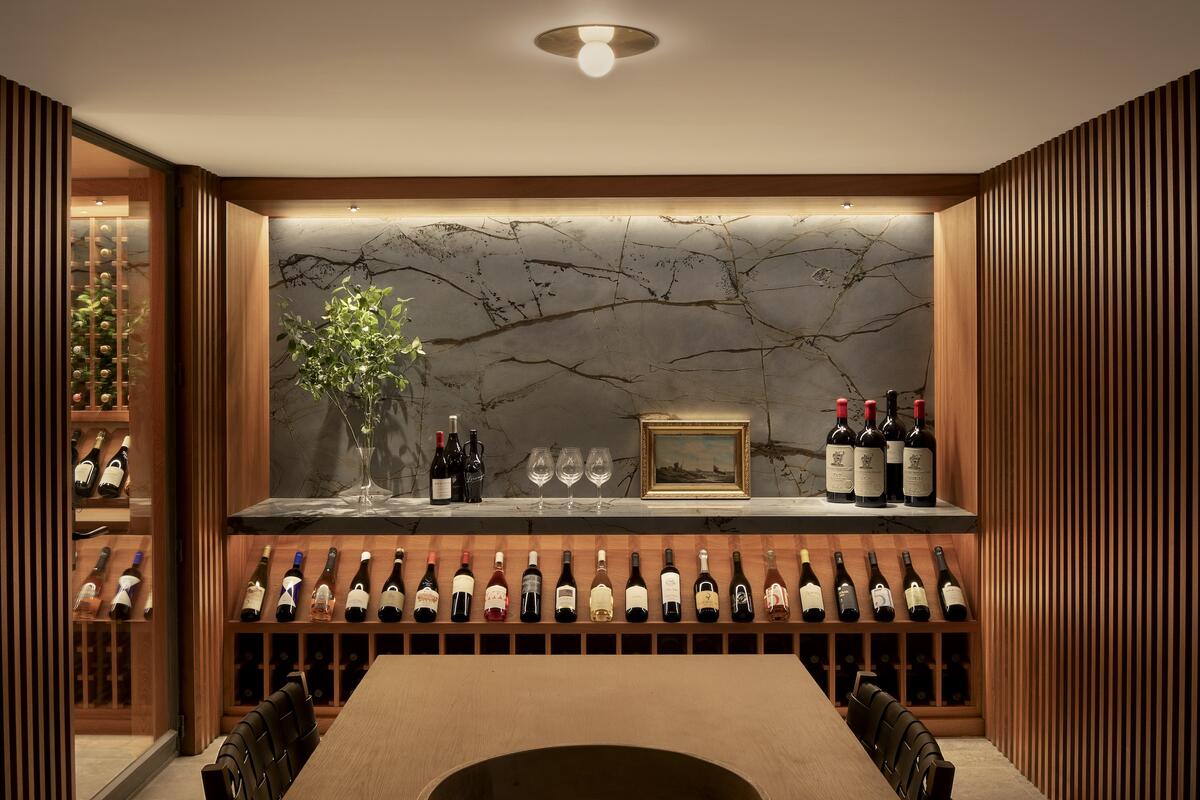
How has being rooted in Portland shaped the opportunities that are coming your way?
A lot of our projects over the last 20 years have been hyperlocal. But Portland has gone through a very tough time in the last four years, and people are afraid to invest as much as they were investing a few years ago. We also have such a high tax rate here. There’s been a mass exodus out of Portland, especially Multnomah County, and the clients who are here are spending less. Our clients are quite savvy, and they know that even if they have $10 million of liquid assets that they could spend on this remodel, it only makes financial sense to spend $1.5 million because that’s all they could ever get back for the property.
We have made a very strategic plan to get out of just being in the Portland area—we want to find clients in Bend—that’s in central Oregon, which is wine country here. We’re doing a project in Austin right now that’s really exciting, and we’d love to be in that market more. And we just finished a house in Phoenix a couple years ago, and there’s so much development happening there.
When you look ahead, what do you see for the firm?
There are two aspects. One is we wrapped up six big projects within a three-month period last year, which is an incredible amount. Normally we wrap one to two [in that time frame], so this was a very high concentration of projects. We’re so busy at the beginning and the end of a project—both require a lot of hand-holding from the senior staff, because we’re making sure that clients are heard and getting taken care of and then that everything comes together exactly like we had promised. So that left us with a pretty weak pipeline.
I had this moment where I was like, “Let’s slow down and be OK with not being on a rocket ship, because I want to get my feet underneath me and be very specific about our next big move.” So I’ve given us 18 months to talk about our ideal client. Where do we want to go? How do I want to spend the next 10 to 15 years, which is probably toward the end of my career? What kind of projects do I want to have as a legacy? I’m just now beginning to understand what that looks like. I don’t have a solid answer, but I’m really close, and I’m excited about it. So it’s TBD, whether that’s a product or an expansion of the business—or maybe we grow to a staff of 25 and have way more projects. Whatever it is, it needs to be for the right reasons and because we have the right clients coming to us. What I’ve realized is that the level of enjoyment and satisfaction is so much more important to me than the financial piece.
How have you approached billing for the firm’s work?
There are two ways we charge. For ground-up construction, we charge a fixed fee based on the percentage of construction. We feel like we can do that with good accuracy because of the projects that we’ve done, and it’s so much easier for our financial planning—it could be a year and a half to two years of design, followed by eight months to two years of construction, so that fee is a nice way to parse it out and have consistent income, and the clients like knowing what they’re paying. Our interiors projects are hourly, [with project budgets] based on a loose percentage of construction, but also on how complicated the project is.
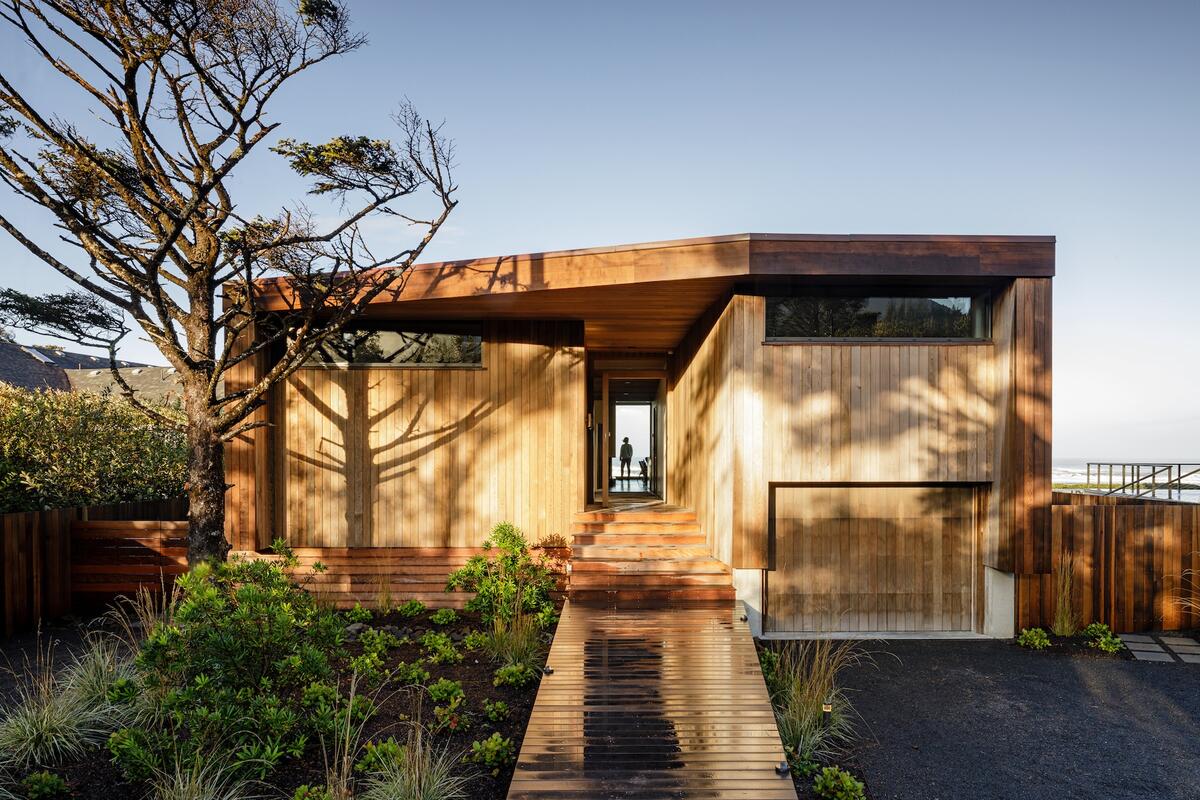
What do you know about the business today that you wish you had known when you were starting out?
Everything. But I would say one of the biggest lessons I’ve learned is to listen to my own intuition—to pause when I felt like I was doing things in a way that I thought other people were doing them and were the right way, but they weren’t necessarily sitting right with what I wanted to do.
What’s an example of that?
One that’s coming to mind is a boutique nine-bedroom bed-and-breakfast called Inn the Ground, located in wine country here in Oregon. The clients are lovely—they decided to exit their shipyard business and wanted to do something quite different. We did a very long lap with them: They had this property that they were looking at developing, and we were really working with them to come up with this vision of what they wanted it to be. And the result is stunning. But that project gave me a lot of gray hairs, because I was trying to be all things to the client.
We ended up bringing in an architect to be the architect of record for the building—we handed them the concept and the master plan, and then they did the core and shell and carried it through permitting and all the way to the end, and we kept the interiors. In retrospect, I think I would have brought bigger partners in sooner in order to understand the potential. When I look back, I took my staff around the track with me at a very high speed trying to produce and come up with the right project for these people, and I think I wore a lot of my team out.
I’ve learned to take things a little bit slower and not get over my skis. I love learning new things, so if someone puts an opportunity in front of me, I will say yes most of the time. But I’ve realized that it’s really hard on my staff if I’m saying yes to all kinds of new things all the time. I guess the concentrated answer in this is: Don’t try to be all things to all people. And collaborating with other design firms, even on the interiors side, can be so fulfilling and rewarding, so don’t be afraid of that. I think in earlier parts of my career, it would have been hard for my ego to let go.
Is there a shortcut to getting better at that?
I think there is, actually. I have built a leadership team here—they’re like a board of directors in a lot of ways. They bring different perspectives, and I think it’s really valuable to listen to that.
What does success look like for you today?
That’s so interesting you’re asking me that, because we’ve had two years of decline in our top-line revenue, which we haven’t experienced in a very, very long time—not since 2009 and 2010. But in the same breath, I feel really comfortable with where we are, and I’m not worried at all. It’s not fun to look at a P&L that’s [not as positive as] you want, but I understand why it’s there, and I want to be really diligent and focused on making the next big move.
So what does success look like? So many different things. Having staff who find a home here and want to invest in JHL feels very successful to me—the tenure of my employees is an important thing. Having projects across the country feels like success, and being able to service different communities and build new relationships with logistics companies, workrooms and all the people who are on the ground in those different places. And then on a personal level, my husband and I have four children together. Our two littles are 7 and 9, and I think a successful career for me feels like having a good balance of being able to spend quality focused time with my family but also being able to get away. Success is feeling like I’m a good mom and a good leader.
To learn more about Holly Freres and JHL Design, visit her website or find her on Instagram.
















